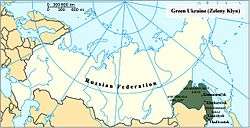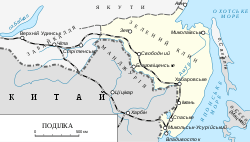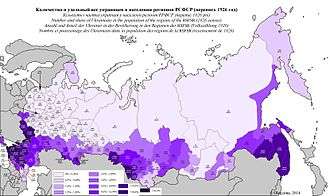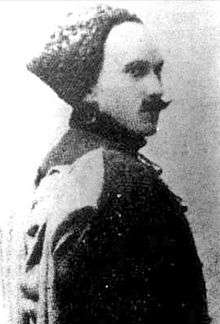Green Ukraine
Green Ukraine, also known as Zeleny Klyn (Ukrainian: Зелений клин, romanized: Zelenyj Klyn, Russian: Зелёный Клин, romanized: Zeljonyj Klin, literally: "the green gore/wedge"),[3] or as Transcathay (Ukrainian: Закитайщина, romanized: Zakytajščyna), is a historical Ukrainian name for the land in the Russian Far East area between the Amur River and the Pacific Ocean, an area roughly corresponding to the Chinese concept of Outer Manchuria.

Green Ukraine | |
|---|---|
 | |
 |
After the Russian Revolution of 1917, the Ukrainian Republic of the Far East was a projected country in the Russian Far East.[4] After the establishment of the Bolshevik Far Eastern Republic on April 6, 1920, Far Eastern areas with an ethnic Ukrainian majority attempted to secede and establish an entity called Green Ukraine. This movement quickly proved abortive.
Historical outline
- 24 June 1917 – First All-Ukrainian Far Eastern Congress at Nikolsk-Ussuriysky formed the Far Eastern Kray Rada (Land Council).
- January 1918 – Second All-Ukrainian Far Eastern Congress at Khabarovsk proclaimed Green Ukraine as part of the Ukrainian State (in spite of the lack of geographical connection).
- April 1918 – The Third All-Ukrainian Far Eastern Congress asked for the creation of an independent Ukrainian state on the Pacific Ocean.
- Summer 1918 – The Far Eastern Ukrainian troops (more than 5,000) enlisted by General Boris Khreschatitsky.
- 11 April 1920 – Order of Hetman Grigory Semyonov on the right of Far Eastern Ukrainians for national self-determination and autonomy in the limits of a united Far Eastern state of Cossacks, Buryats, and Ukrainians.
- 1922 – Dissolution of Green Ukraine.
Head of the Krai Secretariat:
- June 1918–1919 – Yuri Hlushko-Mova (1st time)
- January 1920–1922 – Yuri Hlushko-Mova (2nd time)
Territory
Near the Amur River, Ussuriland, around Khabarovsk and north of Vladivostok.
Religion
Most of the Slavic population were Christians. The local Tungusic peoples followed local religions; some Ashkenazi Jews practiced Judaism.
Hydrography
It would have had a coastline similar to that of the Far Eastern Republic.
History of settlement
The Zeleny Klyn (Ukrainian: Зелений клин), Zelena Ukraina or Eastern Ukraina was an area of land settled by Ukrainians which is a part of the Russian Far East in the area of the Amur River and the Pacific Ocean. It was named by the Ukrainian settlers. The territory consists of over 1,000,000 square kilometres and has a population of 3.1 million (1958). The Ukrainian population in 1897 made up 15% of the Primorskaya Oblast's population.[5]
Zeleny Klyn became part of the Russian Empire much later than Siberia and other parts of the Far East. The first attempts at colonizing the area date back to the mid-17th century when Yerofey Khabarov founded the fort of Albazin on the Amur River. From that time, constant skirmishes took place with the Manchu people of China. In 1689 China and Russia signed the Treaty of Nerchinsk, which granted Russia limited territory.

In the mid 19th century, the second Russian expansion took place after Russia lost the Crimean War (1853–1856). A number of Cossack settlements were established on the Amur river. China had become far weaker than Russia at the time and ceded territory to Russia in the Treaty of Aigun of 1858 and by the Convention of Peking of 1860 (see Amur Annexation).
During this period only a small number of settlers settled in the region consisting of some 14,000 Cossacks and 2,500 Russian soldiers. In 1861 two oblasts were established, the Primorsky and Amur. Vladivostok was founded in 1860, Khabarovsk in 1858.
In 1882 free transportation was announced for settlers to the area from Ukraine and free land was offered to settlers. By 1897 the population had increased to 310,000. With the establishment of the railroad in 1901 over 14,000 settlers were moving to the area per year, with a maximum of 78,000 settlers moving there in 1907.
After 1917 the area came under the jurisdiction of Admiral Alexander Kolchak. In 1920 the Far East Republic was established as a buffer republic between Russia and Japan. In 1922 the republic joined with the Russian Soviet Federative Socialist Republic. In 1934 the Jewish Autonomous Oblast region was established with its capital at Birobidzhan.
See also
Sources
- Encyclopedia of Ukraine, Volume 2, Paris 1957
References
- Smith, Ned (24 February 2001). "Green Ukraine / Ukrainian Far East (1921, Russian Far East)". FOTW "Flags Of The World". CRW Flags. Retrieved 24 October 2018.
In “Flags of Non-Russian Peoples Under Soviet Rule” by Prof. Walter Trembicky [tbc69], pages 134 and 135, it mentions two proposed flags for Green Ukraine, or the Ukrainian Far East, neither of which was officially adopted, since the movement quickly proved abortive. There are simple black & white line drawings illustrating the two proposed flags on p. 133 of [tbc69]. The green in the two flags was described as dark or deep green. ... One [of the two proposed flags] was the Ukrainian blue-over-gold bicolor with a green triangle at the hoist.
- Trembicky, Walter (1969). Flags of Non-Russian Peoples Under Soviet Rule. Flag Research Center. pp. 134, 135.
- The flag of Green Ukraine appears to be a play on words on the concept of a "green wedge" combined with traditional Ukrainian colors. Ukrainian parlance also referred to other ethnic enclaves as "wedges" - note the yellow wedge, the grey wedge, and the purple wedge - compare Ukrainian historical regions.)
- Jonathan D. Smele (2015). Historical Dictionary of the Russian Civil Wars, 1916-1926. Rowman & Littlefield. p.476. ISBN 1442252812
- "Russian Census of 1897". Demoscope.ru. Retrieved 2014-03-03.
